The regular runner on the Sunday mid-day team laces up the new ASICS Metaracer and finds a spring in her step. But, the question is does advanced technology in the running shoe market actually help the amateur runner?
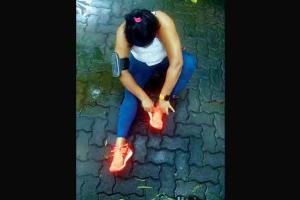
This writer tested the Metaracer. Lighter than the Gel Nimbus 21, she usually wears, they felt like a nimble run. The cushioning on the heel didn't feel inadequate, considering it was a lighter shoe. Pics/ Atul Kamble
The idea was to keep a medium pace for the first four kilometres of the 8-km run. That would have been around 8.25 minutes per km for me. But, this Thursday evening, the body had a different plan. Ever so often it would slip into the late 7.00s and I had to consciously lower the pace. For someone who clocked a 60-minute 5k run in May—an anomaly we'll blame on the heat and a heavy lunch—memories of trying, with great futility, to increase the pace, were still vivid. While that slow run was clocked on the ASICS Gel Nimbus 21, this one was on the ASICS Metaracer, said to be the sporting firm's most advanced distance racing shoe. Besides of course its shiny exterior, the Metaracer is much lighter than the Gel Nimbus. Getting into the shoe, I worried that I was trying to wear a supermodel's clothes.
ADVERTISEMENT
The point of course, is not the size, but if one size fits all. Earlier this month, Olympic marathon champion Eliud Kipchoge announced that he would use the Nike Vaporfly Next % to defend his London Marathon title on October 4. It's these shoes that he had worn in October 2019 when he broke the two-hour mark for a marathon distance for the Ineos 1:59 Challenge. While there was talk that the Vaporfly range gave undue advantage to other runners, owing to its sole technology, World Athletics—the global athletics governing body—decided against a ban on the shoes, saying any new shoe technology developed after April 30, 2020, would have to be available on the open market for four months before an athlete could use it in competition. It also introduced an immediate indefinite ban on any shoes that have a sole thicker than 40 millimetres.

Dr Tom Allen
Dr Thomas Allen, senior lecturer at the Department of Engineering at UK's Manchester Metropolitan University, has a background in research in the field of sports engineering, and collaborates with a number of sports brands. He says that running shoes started to become more technologically advanced around the 1970s, with the introduction of the new materials like EVA (ethylene vinyl acetate) foam for the midsole.
"That's about the time that the footwear brands really started to apply advanced engineering to the design of their shoes. Running was also becoming more popular, so it was a combination of these two factors which drove developments in the shoes," he adds.
He breaks down the main components of a running shoe into the outsole, the midsole and the upper. The outsole, typically made of rubber, has the tread pattern that gives the shoe the grip. The midsole, which sits underneath the foot, is often made of foam and absorbs the shock from foot strike, while the upper is the top part of the shoe which surrounds the foot, and it also has a fastening system, normally laces. "The midsole is an important part of the shoe, and changes in its thickness and mass can impact the running economy of the wearer, allowing them to run faster for longer. A recent trend in high-end running shoes is thick midsoles." This recent development, he adds, is largely because of technological developments in foam materials, which allow for the midsole to be thick, yet lightweight.
Initially, switching from the Gel Nimbus to the Metaracer felt strange for the feet. Where the Gel Nimbus feels like being fitted into protective armour, the Metaracer is light on the feet. It may have been purely in the mind, but I felt more nimble with the Metaracer and the kilometres kept passing by, with less effort than usual.
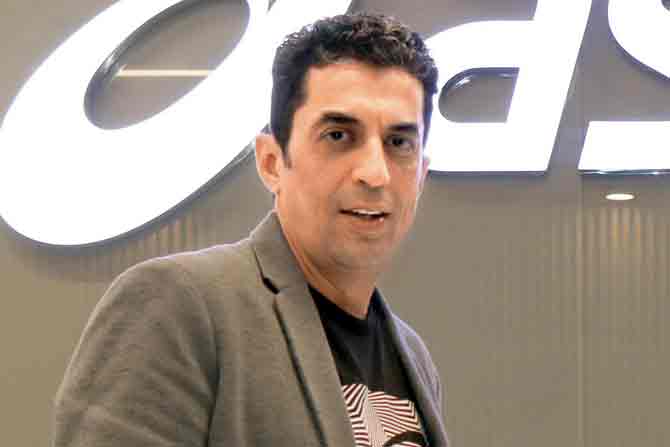
Rajat Khurana
Rajat Khurana, managing director, ASICS India and South Asia, says that the Metaracer is ideal for fast marathon-distance runners who want to compete, and so, improve their timings. That is, elite athletes. Would a shoe like this, help the average marathon runner? "It helps everyone improve their timing by reducing fatigue as it is an energy-efficient shoe." Breaking it down, he adds, that the shoe has a trademarked GUIDESOLE technology, where the sole is curved near the toe and the forefoot is a bit stiff. Much like how a rocking chair operates, he says. This ensures a little pressure at the back of the foot helps the leg go faster, without expending much energy when you go front. The slightly stiff forefoot ensures that the foot is stabilised, reducing ankle flex, meaning that muscles have to work less, thus causing less fatigue. It's ideal for marathons and half-marathons. The upper of the shoe is also lightweight. It throws off any sweat or water, thus ensuring that the weight of the shoe remains optimum for the runner. The Flytefoam midsole makes the shoe light. One concern I had while running with the Metaracer was the cushioning it gave the heel, given my history of plantar fasciitis. And though, it is a race-day shoe, the foot didn't feel overtly exposed.
Where the Metaracer is meant to make you faster, the Gel Nimbus, says Khurana, is meant to protect you. "It's a full marathon shoe, and is meant for people who compete in the normal category. A normal runner's foot is not as strong as an elite athlete's. They have more training. And so, the heel drop—difference in height between the heel and the forefoot in the midsole—is greater for the Gel Nimbus than in the Metaracer, which has been designed for energy efficiency."
Like the Metaracer, the Vaporfly Next% too is said to be Nike's fastest shoe ever. It's said to have merged traction patterns of marathoners Geoffrey Kirui, Kipchoge and Mo Farah. It boasts of Vaporweave, an upper material that is lighter than the Nike Flyknit, breathable and, as in the Metaracer, absorbs far less water from sweat or rain, so it stays dry over the course of a marathon. It also has a thin foam pod inside the heel to ease the pressure off the Achilles and also the Nike ZoomX foam in the midsole, which has been scientifically proven in Nike's Sport Research Lab to further increase energy return.
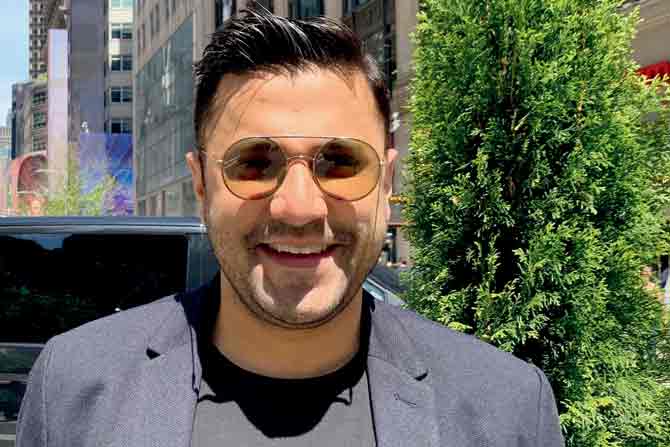
Siddharth Pal
But, ASICS and Nike aren't the only ones. In a competitive running shoe market, where new tech is being tested every day to improve the running experience, there's also the Under Armour HOVR Machina. Named after its patented HOVR foam, the Machina hopes to be the answer to those who choose between cushioning and lightweight shoes. Explaining this, Siddharth Pal, marketing head for Under Armour India, says the shoe aims to give a zero-gravity feel to the runner. "It also provides stability for those who carry more weight and thus often, have ankle or heel issues." While the Machina has similar features as the Metaracer and the Next%, where it may have an added advantage is that it's a shoe that speaks to the runner.
Built in with a chip, the shoe connects with UA's MapMyRun app, which will record the make, the colour, giving the shoe a unique identity. While you run, the shoe will record your pace, cadence. It will even coach you and give real-time guidance through the app, says Pal. The shoe, he says, is also suited for amateur runners, who will get training through.
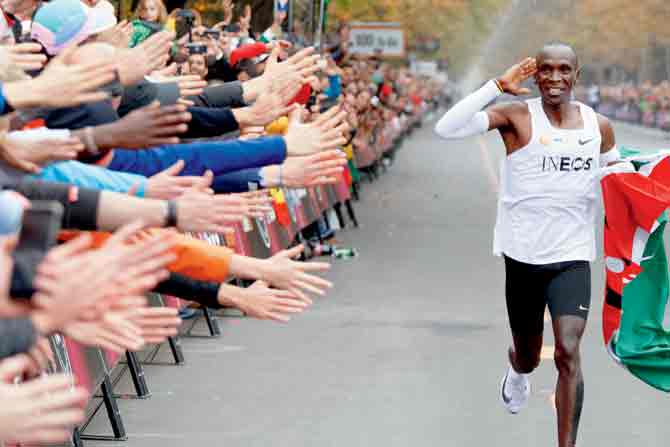
Kenya's Eliud Kipchoge celebrates after completing a full marathon with an unofficial time of 1hr 59min 40.2sec, becoming the first ever to run a marathon in under two hours, at a specially prepared course in Prater park, Vienna. PIC/getty images
As someone who isn't a lightweight runner, one wonders if weight should be a consideration while picking up a shoe. The Metaracer, amazing as it is, provides less protection than the Gel Nimbus 21, and so each time post run when the heels hurt a bit more, one wonders if it's the shoe or the body. Dr Allen says, "The vertical force which is transferred to the runner during the foot strike increases with both their body weight and speed. For a lightweight, fast elite runner this force will be about three times their body weight. Heavier runners tend to be slower, with vertical ground reaction forces around twice their body weight."
While my last 8k was in February this year (with a 76-minute timing), the nearest 7k was on August 6, clocking 64.03 minutes. The 8k run with the Metaracer was clocked at 70.35 minutes. Could a shoe have made all the difference? Speaking about the promise of a faster run with the latest shoes, Dr Allen says, "It depends on the athlete. Some people may not see much difference in their running economy, while others may see an improvement of around five per cent." Coach Giles Drego, attributes the pace to regular training, saying a shoe doesn't help.

Shayamal Vallabhjee, sports scientist and psychologist
Shayamal Vallabhjee, sports scientist and psychologist, says multiple factors decide a runner's pace. And they start with how much lean muscle, body mass the runner has, their cadence (total number of steps taken in a minute), fast twitch muscle fibre ratio (the ratio in the body of the kind of skeletal muscle fibres that support powerful movements), body type, leg length, fuelling source, injuries, training patterns, the mileage a runner puts in through the week, psychological factors such as the runners pain threshold. "Can a shoe increase a runner's performance? Yes. But Kipchoge for example, is a runner who is training at his optimal. When the Next% was designed it was done so, keeping in mind that he needed a four per cent improvement to make the sub-2 mark. During a conversation, Kipchoge told me that even with a normal running shoe, say something you'd pick off the streets, he's run a 2:08 marathon. So, for elite athletes such as him, a shoe will make a difference."
A novice runner, Vallabhjee adds, will not benefit from a faster shoe. They need to get other things correct first—three days of strength training; better fuelling; maximise training (run thrice the distance of the race-day event every week). "Telling someone that they can wear a shoe and become faster without taking into account the other factors is like telling a student that by using a magic pen they can ace an exam without studying," says Vallabhjee.
Asics Metaracer
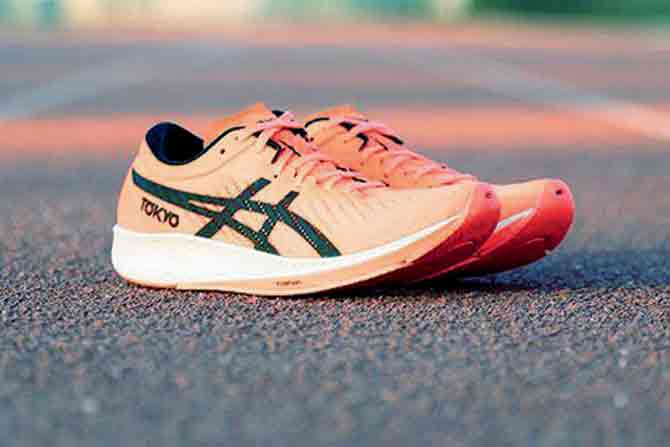
The FLYTEFOAM™ technology in the midsole is lightweight and gives both a softer run and improved responsiveness.
WET GRIP RUBBER™ outsole technology provides traction in wet conditions to help runners maintain a consistent stride.
GUIDESOLE™ technology with a rocker sole helps propel you forward, which gives you the ability to move through your running motion more smoothly and efficiently.
A lightweight carbon plate runs from the midfoot forward to add structure and rigidity to the shoe.
AHAR™ rubber is a highly durable material that’s placed in key areas where the load is applied at the landing phase of the stride.
The Nike ZoomX Vaporfly NEXT% ADVANTAGE
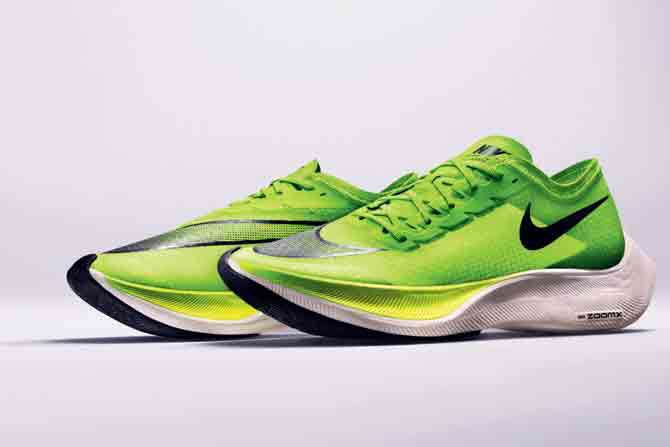
Vaporweave, a material construction debuting on the upper, is lighter than Nike Flyknit, breathable and—critically—absorbs far less water from sweat or rain, so it stays airy and dry over the course of a marathon.
The laces are slightly offset to alleviate pressure along the sensitive part of the foot.
Nike ZoomX foam in the midsole, which has been scientifically proven in Nike’s Sport Research Lab to further increase energy return, has been redistributed to decrease the offset from 11mm to 8mm to provide a more stable feeling and help maximize energy return at the critical toe-off.
A thin foam pod inside the heel keeps the Achilles happy.
UA Hovr Machina
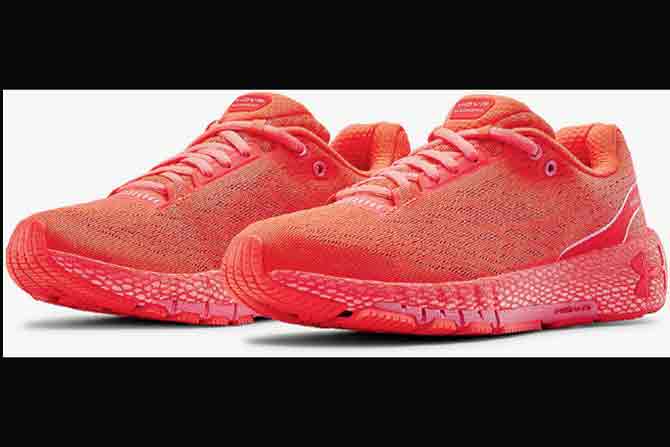
- NEUTRAL: For runners who need a balance of flexibility & cushioning.
- UA HOVR™ technology provides ‘zero gravity feel’ to maintain energy return that helps eliminate impact.
- Compression mesh Energy Web contains & molds UA HOVR™ foam to give back the energy you put in.
- Engineered mesh upper is extremely lightweight & breathable for ultimate speed.
- Sprint spike-inspired carbon-filled Pebax® speed plate for increased return & more powerful push-offs.
- Carbon rubber pods under the heel deliver greater traction & durability at high-impact strike zones.
Keep scrolling to read more news
Catch up on all the latest Mumbai news, crime news, current affairs, and a complete guide from food to things to do and events across Mumbai. Also download the new mid-day Android and iOS apps to get latest updates.
Mid-Day is now on Telegram. Click here to join our channel (@middayinfomedialtd) and stay updated with the latest news
 Subscribe today by clicking the link and stay updated with the latest news!" Click here!
Subscribe today by clicking the link and stay updated with the latest news!" Click here!






